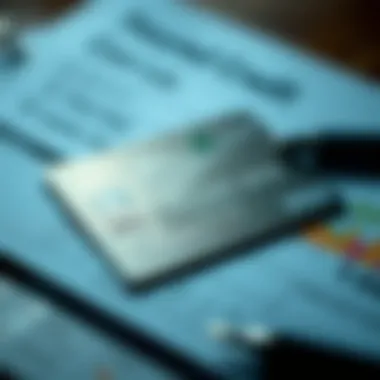Top Secured Credit Cards After Chapter 13 Bankruptcy


Intro
Navigating life after Chapter 13 bankruptcy can feel like trying to swim against a strong current. The waters are choppy, and your financial situation looks like a stormy sea. However, securing a credit card can be a crucial step toward steadying your financial boat.
Understanding what a secured credit card can offer is fundamental. It's an investment in your financial future, designed to rebuild your credit score while offering the flexibility of modern card use. Think of it as a stepping stone, helping you transition from troubled waters to calmer seas.
In this article, we will explore the landscape of secured credit cards available after experiencing a Chapter 13 bankruptcy. We will begin by defining key financial terms that are essential for grasping how secured credit cards work. Following that, we will delve into expert insights, discussing investment strategies and market trends surrounding these financial products.
Ultimately, this guide aims to equip you with the tools you need to make informed decisions, helping you regain control of your financial life post-bankruptcy.
Understanding Chapter Bankruptcy
Navigating the waters of personal finance can feel like swimming in a choppy sea, especially when faced with the aftermath of bankruptcy. Understanding Chapter 13 bankruptcy is paramount for anyone looking to start afresh financially. This section serves as a foundation, elucidating what Chapter 13 is, how the process unfolds, and its implications for one’s credit score. These aspects are crucial for making informed decisions when it comes to rebuilding credit through secured credit cards after bankruptcy.
Defining Chapter Bankruptcy
Chapter 13 bankruptcy, often referred to as a "wage earner's plan," allows individuals with a regular income to devise a strategy to repay all or part of their debts over time. Unlike Chapter 7, which liquidates assets, this chapter enables debtors to keep their property while catching up on overdue payments. The hallmark of Chapter 13 is creating a repayment plan that typically lasts three to five years, depending on the debtor’s income and financial situation. This offers a structured approach to resolving debts while shielding the individual from creditor actions.
Process and Duration
The journey through Chapter 13 begins with filing a petition in bankruptcy court. Following this, the debtor presents a repayment plan to the court, detailing how they will repay their creditors over the specified duration. The process includes mandatory credit counseling and might require court hearings to confirm the repayment plan.
- Total Duration: Generally, the entire process can take anywhere from three to five years. During this period, the individual is protected from collection activities, giving them a much-needed breather. However, sticking to the plan is essential; failure to do so may result in dismissal of the case, leading to more significant financial stress.
Impacts on Credit Score
Declaring Chapter 13 does have repercussions on one’s credit score, and understanding these impacts is crucial for future financial endeavors. Initially, a Chapter 13 filing can cause a drop in the credit score, often viewed as a significant negative mark. However, as payments are made according to the plan, the credit score can gradually improve.
The bankruptcy will remain on the credit report for up to seven years, but with diligent financial habits and the responsible use of secured credit cards, individuals can rebuild their credit scores and enhance their financial standing over time. Building new credit is possible; it just requires a patient and strategic approach.
An important takeaway is that while the initial damage to the credit score may sting, diligent repayment can lead to recovery and better credit opportunities in the future.
Understanding Chapter 13 bankruptcy sets the stage for the second act of financial recovery, where secured credit cards play a critical role. With this knowledge, individuals can make empowered choices about their financial futures.
The Need for a Secured Credit Card
After experiencing the tumultuous journey of Chapter 13 bankruptcy, many individuals find themselves grappling with the daunting task of rebuilding their financial life. Having a secured credit card in your arsenal can be a strategic move during this delicate phase of recovery. It's not just a method to help your credit bounce back; it's also a lifeline that fosters responsible financial habits and provides a pathway to a more promising financial future.
Rebuilding Credit Post-Bankruptcy
Rebuilding credit after a chapter 13 is akin to playing a long game. You might feel like you're trying to climb a mountain with a boulder tied to your back. However, secured credit cards serve as valuable tools in this climb. These cards require a cash deposit that acts as collateral, granting users a credit limit typically equal to that deposit. This mechanism means lenders have a safety net, making them more willing to extend credit to those with challenging credit histories.
Employing a secured card for regular expenses—like groceries or utility bills—while paying off the balance in full each month can show potential creditors that you're regaining control. Not only will this consistent repayment behavior slowly enhance your credit score, but it can also lay the groundwork for future unsecured credit. In this regard, a secured credit card is not just a financial product; it's a brush that helps you repaint your credit picture.
Functionality of Secured Credit Cards
Secured credit cards hold a unique place in the financial ecosystem, especially for those emerging from bankruptcy. Here are a few pertinent aspects to understand:
- Accessibility: Unlike traditional credit cards that might be off-limits post-bankruptcy, secured cards are more accessible. Lenders recognize that your past doesn’t eliminate your potential for responsible billing.
- Simple Setup: To get started, you usually need to provide a security deposit, which not only secures your card but also determines your credit limit. This clear structure helps consumers know exactly how much they can spend and helps them resist the temptation to overspend.
- Credit Reporting: Most secured credit cards report to the major credit bureaus, which means your payment history will influence your credit score positively (or negatively). Having these transactions documented helps build your credit report, essential to navigate away from past financial pitfalls.


In sum, secured credit cards serve not only as a means of credit but also as a training ground for sound financial practices. For individuals who have experienced bankruptcy, these cards can turn the tide, enabling a smoother transition towards achieving financial stability. Remember, it’s a gradual journey, but with careful navigation, it’s entirely feasible to regain solid footing on your financial path.
Choosing the Best Secured Credit Card
Selecting the right secured credit card is crucial for individuals looking to rebuild their credit after a Chapter 13 bankruptcy. Not all secured cards are created equal, and different cards come with varying features, associated costs, and conditions. When you choose wisely, you empower yourself to repair your financial reputation and build a healthier credit history.
Key Features to Consider
When evaluating secured credit cards, certain features must capture your attention. Understanding these key elements will help you make an informed decision.
Annual Fees
Annual fees can be a double-edged sword. While some secured credit cards come with a waiver of annual fees, others may hit you with a hefty charge just for keeping the card. It’s essential to scrutinize this aspect because high annual fees can eat into the limited financial resources you have after bankruptcy. A card without an annual fee is preferable—it allows your payments to go further toward rebuilding your credit instead of unjust fees. Furthermore, some cards offer additional features or rewards despite having a fee, which could be worth considering if you anticipate using the card frequently.
Security Deposit Requirements
The security deposit is essentially the backbone of a secured credit card. This deposit acts as collateral and usually determines your credit limit. Payment histories are reported to credit bureaus, and the amount you deposit can have a significant impact. It's important to choose a card requiring a deposit that you can manage, as some issuers might require as much as several hundred dollars, which can be burdensome. On the flip side, lower deposit requirements mean you can start rebuilding faster, though they may come with limited credit lines.
Interest Rates
Interest rates are another key consideration. Depending on the card, interest rates can vary widely, and a high rate can put in a tight spot if you are unable to pay off balances fully each month. Understanding the Annual Percentage Rate (APR) is essential because, if you carry a balance, you will incur interest charges that can snowball quickly. Cards with lower interest rates may be more beneficial, especially as they provide a cushion against accumulating debt, thus aiding your recovery post-bankruptcy.
Eligibility Requirements
Eligibility requirements are the criteria set by credit card issuers to determine whether you qualify for a secured credit card. After a Chapter 13 bankruptcy, it’s vital to fully understand what banks look for. Generally, most issuers will assess your credit history, verifying that you've made timely payments on any debts since your bankruptcy as a sign of responsibility. Besides, income verification often plays a role too. A consistent income reassures the issuer that you will be able to make timely payments, which in turn supports the goal of rebuilding your credit.
Credit Reporting Practices
When you obtain a secured credit card, one of the most important things to look at is how the issuer handles credit reporting. Do they report to major credit bureaus? Is the frequency consistent? These practices are pivotal in helping you recover your credit score. Consistent reporting of on-time payments can help you raise your score over time, while missed payments can set you back. Always confirm that the issuer reports to the three major credit bureaus: Experian, TransUnion, and Equifax. Moreover, you should ensure that they report your account activity accurately to fully leverage the benefits of having a secured card.
Top Secured Credit Card Options
After navigating the choppy waters of Chapter 13 bankruptcy, many find themselves on the lookout for secured credit card options to aid in rebuilding their credit scores. Opting for the right secured credit card can be pivotal in creating a more stable financial future. Here’s why it's significant to consider various secured credit card offerings.
Choosing a secured card isn't merely about picking the one with the flashiest logo. It's about comprehending the specific benefits, costs, and suitability of each option. Different cards may cater to various lifestyles, needs, and financial goals. Therefore, it’s essential to evaluate each option carefully to ensure you’re making a sound investment in your financial recovery journey.
A secured credit card is not just a tool for spending; it can be an ally in restoring your financial reputation and regaining control over your economic life.
Capital One Secured Mastercard
The Capital One Secured Mastercard is often touted for its balance of accessibility and functionality. One of its standout features is the potential to increase your credit limit after just five months of on-time payments, which allows cardholders to gradually build their creditworthiness without needing a substantial upfront deposit. With an initial deposit as low as $49, this card makes entry feasible for many who may feel like they are already scraping the bottom of the barrel.
Moreover, it reports to the major credit bureaus, which is crucial for rehabilitating your credit score. The card also offers various additional perks, such as benefits that come with responsible usage, like no annual fee and access to a mobile app for easy account management. This card exemplifies a supportive option for cardholders embarking on the lengthy journey to financial recuperation.
Discover it Secured Credit Card
When it comes to secured credit cards, the Discover it Secured Credit Card deserves special mention. While its security deposit acts as an insurance policy for the credit issuer, this card offers a unique cashback rewards program, allowing users to earn 2% cash back at gas stations and restaurants on up to $1,000 in combined purchases each quarter, and 1% on all other purchases. This may sound counter-intuitive for a secured card, but it provides valuable incentives for wise spending.
Additionally, Discover provides a capability known as “Quarterly Spending Tracker,” which can help in monitoring expenditures and adjusting habits if necessary. With no annual fee and reporting to all three major credit bureaus, this option is decidedly attractive for those serious about turning over a new leaf in their financial health.
OpenSky Secured Visa Credit Card


The OpenSky Secured Visa Credit Card is distinct in its approach. First off, it does not require a credit check for approval, which is appealing for those who might have been denied by other issuers in the past. Cardholders can start with a security deposit as low as $200, which serves as their credit limit. This makes it a feasible option for many recovering from bankruptcy.
One of the notable aspects of OpenSky is its straightforward fee structure. There’s an annual fee, sure, but some find the lack of other hidden fees refreshing. It reports to the three major credit bureaus, aiding in credit score recovery. However, some users might find the app and online banking functionality a bit behind more technologically advanced competitors, so that’s something to keep in mind.
Citi Secured Mastercard
Lastly, the Citi Secured Mastercard presents yet another favorable secured card choice for individuals looking to rebuild their credit. What distinguishes this card is its robust online platform and excellent customer service. With a minimum deposit starting at $200, cardholders can gain access to a credit limit up to their deposit amount.
The card not only reports to major credit bureaus but also offers free access to credit score tracking, which is immensely beneficial for monitoring progress. However, be aware of the annual fee that could apply after the first year, as you're navigating your recovery journey. Overall, it’s an effective credit-building tool, especially for those who value strong customer support and transparency in account management.
When considering secured cards, assess how their features align with your unique needs and financial goals. The right choice can set you on a path towards reestablishing your credit and achieving your aspirations.
Benefits of Secured Credit Cards
Secured credit cards offer a lifeline for those looking to recover financially after experiencing Chapter 13 bankruptcy. These cards have unique features that can be transformative for individuals aiming to rebuild their credit ratings and manage their finances with more efficacy. When you've weathered a storm like bankruptcy, understanding the benefits of secured credit cards becomes crucial for your financial recovery journey.
Credit Score Improvement
One of the most significant advantages of using a secured credit card is its potential to improve your credit score. Simply put, these cards report your payment history to credit bureaus, just like unsecured cards. By consistently making timely payments, you can demonstrate reliable payment behavior, which is a key component of your credit score. Having a solid payment history not only helps to counter the negative impacts of bankruptcy but also shows creditors that you’re responsible with your borrowing.
It's not all about just making payments, though. The utilization rate—the ratio of your credit card balances to their limits—also plays a role in credit scoring. Secured cards often come with a low limit relative to your security deposit, which makes it easier to keep balances low. This strategic approach helps your credit case significantly. In other words, keeping your balances under the limit keeps you in good standing and can uplift your credit score faster than you might think. (
Financial Management Skills
Using a secured credit card can also contribute to enhancing your financial management skills. These cards require a deposit that acts as your credit limit, which makes budgeting an essential practice. Since the amount you deposit determines how much you can spend, it compels cardholders to be more mindful about their expenditures.
Over time, managing a secured card can cultivate habits like tracking expenses, setting budgets, and learning when to cut back—all essential skills for maintaining healthy finances. Additionally, as you master these tasks, you gain confidence in your ability to handle credit responsibly. This is a vital area of growth especially after dealing with the emotional and financial strain from bankruptcy.
Path to Unsecured Credit Products
A marked, yet often overlooked, benefit of using a secured credit card is that it can serve as a stepping stone to achieving unsecured credit products. Many credit card issuers track your activity with a secured card and may transition you to an unsecured card if you maintain a solid payment history. This transition is typically quicker than you might expect; it can occur as little as six to twelve months after your initial use of the secured card.
In some ways, it’s like following a treasure map, with your secured card acting as the first marker leading you towards a point where you can access better credit options without the need for a security deposit. The key is to consistently manage your credit responsibly, demonstrating that you’re capable of handling more versatile credit products.
"Secured credit cards are not just tools for restoring credit; they are pathways to better financial practices and opportunities."
In summary, the benefits of secured credit cards are multifaceted. From credit score improvement to enhancing financial management skills and paving the way to unsecured credit options, these cards can be vital for many navigating their financial recovery after a Chapter 13 bankruptcy. Understanding and leveraging these benefits effectively can lead to a firmer financial future.
Best Practices for Using a Secured Card
Using a secured credit card offers significant opportunities for rebuilding one’s financial standing, especially after a Chapter 13 bankruptcy. However, to truly benefit from this financial tool, one must embrace certain best practices. These practices lay the groundwork for bolstering a credit score while instilling responsible credit usage habits. In this section, we'll delve into practices that can lead to a successful experience with secured credit cards.
Timely Payments
The importance of making timely payments cannot be overstated. Delinquency on payments can lead to fees and, more importantly, it can wreak havoc on your credit score. When you make payments consistently and on time, you're not only adhering to the terms of your credit agreement but actively demonstrating your ability to manage debt.
Consider setting up automated payments or reminders; this helps ensure you never miss a due date. When you approach your payment responsibilities with diligence, you're slowly but surely mending the wounds left from previous financial missteps.
"On-time payments are the cornerstone of any good credit history."
Keeping Balances Low


Another piece of sage advice is to keep balances low relative to your credit limit. This practice, often termed credit utilization, refers to the ratio of your credit card balances to your total credit limit. According to financial experts, maintaining a utilization rate below 30% is ideal. This means if your secured card has a limit of $500, try to avoid charging more than $150 at any given time.
Staying within this threshold does wonders for your credit score. Imagine trying to balance on a tightrope; the lower your balances, the steadier you remain. It's all about stability and demonstrating restraint. Some individuals even find it beneficial to have a small recurring charge that they pay off entirely each month. This not only keeps balances low but also keeps your payment history pristine.
Regular Monitoring of Credit Score
Lastly, engaging in regular monitoring of your credit score is not just a precaution; it’s a necessity. Knowing where you stand allows you to identify trends or sudden changes that could indicate fraud or mismanagement. Many banks and credit card companies provide monthly access to your score, alongside tools and resources to understand it.
Use this information to inform your financial decisions. For instance, if you see your score improving, it may encourage you to apply for additional credit responsibly. Conversely, a drop in your score signals that it might be time to reassess your credit habits.
Maintaining a vigilant eye on your credit score serves as a barometer for your financial health; after all, knowledge is power in the world of finance.
Potential Pitfalls of Secured Credit Cards
Navigating the landscape of secured credit cards can be tricky, especially when one is on the path of recovery after a Chapter 13 bankruptcy. While these cards serve as valuable tools for rebuilding credit, they also come with their share of challenges. It's vital to be aware of these potential pitfalls to make informed choices that support your financial goals.
High Fees and Charges
One prominent concern regarding secured credit cards is the high fees associated with them. Some issuers may charge annual fees, application fees, and even security deposit fees. It's important to scrutinize the fee structure before getting locked into a contract. For instance, a card might have a relatively low-interest rate, but those fees can add up like a snowball rolling downhill, eating into your finances.
Interestingly, not all secured cards charge the same amount, and some might even waive fees entirely for responsible users. So, it’s worth shopping around, comparing offerings, and reading the fine print. Look for cards that offer transparent pricing and minimal fees; these options can create a more sustainable path towards rebuilding credit.
"Understanding the total cost of a secured card is just as crucial as knowing your credit limit. Keep your eyes peeled for hidden shrimpers in the fine print!"
Impact on Credit Utilization
The impact of secured credit cards on credit utilization is another critical factor. Credit utilization refers to the ratio of credit used relative to the total credit available. Lenders typically recommend keeping this ratio below 30% to maintain a favorable credit score. However, many secured credit cards have low credit limits, often set at the same amount as the security deposit.
For example, if you put down a $300 security deposit, that’s your credit limit. Spending $100 equals about 33% utilization, which could negatively impact your credit score. Therefore, it’s essential to handle your spending wisely, keeping balances low and payments regular. The last thing you want is to recover from bankruptcy only to fall into the trap of poor credit management due to high utilization rates.
In summary, while secured credit cards can be an excellent tool for rebuilding credit after Chapter 13 bankruptcy, they’re not without their drawbacks. Awareness of fees and careful management of credit utilization can help mitigate risks. Your financial future relies on making informed choices, so tread cautiously and prioritize understanding the landscape you’re stepping into.
Building a Stronger Financial Future
After navigating the turbulent waters of Chapter 13 bankruptcy, figuring out how to solidify a financial future can feel like climbing a steep mountain without any climbing gear. This section emphasizes the importance of taking calculated steps and understanding the nuances of building a stable foundation amid the challenges of past financial missteps. The road to recovery doesn’t just entail getting a secured credit card; it’s about laying down the groundwork for sustainable financial practices that pave the way to long-term stability.
Transitioning to Unsecured Lines of Credit
One of the prime objectives for individuals who have filed for Chapter 13 bankruptcy is to eventually transition to unsecured lines of credit. It’s like graduating from a support group to standing on your own. Secured credit cards act as a learning platform, where users have the chance to practice responsible spending and timely payments. Over time, as your credit score improves, it becomes feasible to apply for unsecured credit cards, which often offer better interest rates and rewards offerings.
To facilitate this transition effectively, consider these factors:
- Consistent Payment Tracking: Make sure to keep track of your payment due dates. Missing payments can damper your chances of transitioning smoothly.
- Credit Utilization: Ideally, keep your utilization ratio below 30%. This means not spending more than 30% of your available credit.
- Building Relationships with Lenders: Consider establishing a rapport with your bank or credit union during your secured card period. They often have special offers for loyal customers when it's time to switch.
The ultimate aim here is to rebuild trust with creditors and show that you can handle credit responsibly. Remember, each step taken towards securing an unsecured line is a marker of your growth.
Continuing Financial Education
The journey doesn’t end with acquiring a secured card or transitioning to unsecured credit. Financial literacy is key in fostering a durable financial future. It could be said that knowledge is power. This means being aware of your rights, understanding how interest works, and knowing the implications of debt.
There are a plethora of resources available today that can enrich your understanding of finance:
- Online Courses: Platforms like Coursera or Khan Academy offer free courses on personal finance, credit management, and budgeting.
- Books and Blogs: Consider diving into finance literature. Books such as "The Total Money Makeover" can provide fresh insights. Financial blogs can also be a goldmine of practical tips and real-life experiences.
- Community Engagement: Forums on sites like Reddit can connect you to support groups who have similar experiences. Hearing others’ journey can be enlightening and encouraging.
Taking the time to educate yourself about financial practices is like equipping yourself with the tools needed for home repairs. Instead of paying someone else to fix things, you gain mastery over your financial well-being.
Investing in your financial education is akin to planting seeds today for tomorrow’s harvest. The deeper your understanding of personal finance, the better equipped you are to handle future challenges.







